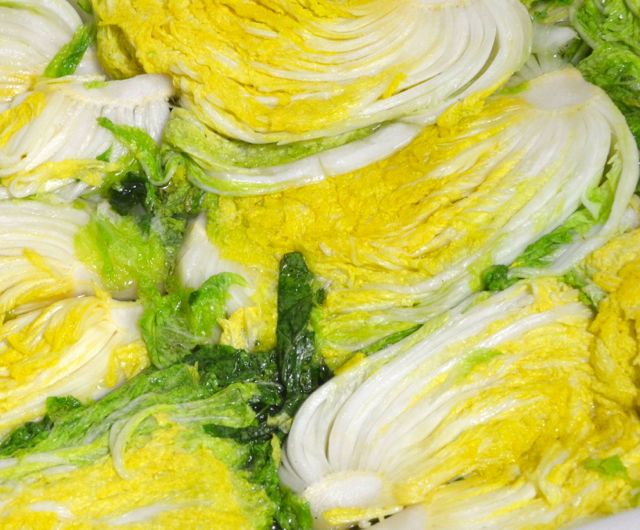
About this time last year I helped my mother-in-law’s Kimjang at her house and in return, I brought home couple containers of her yummy Kimjang. This year, I decided that it was time I tried it all on my own. I was a bit worried that I may not be able to handle the large amount of ingredients but hey, you have to take risks in life, right?
In late September, after my potato harvest, we planted Korean cabbages (배추 Baechoo), radishes (무우 Moo), Korean leeks (대파 Daepa) and mustard greens(갓 kaat) at our family farm for Kimjang.
After about 2 months, they were ready for picking. These pictures were taken around 11/20 or so. I came home with 16 cabbages, 9 radishes and a huge bunch of mustard greens. Also about two large bunches of Korean leeks. I bought the rest from the market.
Because I basically used the same Kimjang kimchi recipe from last year I will not list it again here. However, I will write more in depth about prep work- especially brining/salting cabbages. I know I mentioned in my last year’s post how most people just buy already brined cabbages (절임 배추 jeorim baechoo) because people say that’s the most difficult part of Kimjang both in terms of complexity and effort. You can use these tips for pickling cabbages in making regular small batch Kimchi at home.
How to brine (pickle) Korean napa cabbage (배추 baechoo) for Kimchi:
Ingredients
- 5 KOREAN NAPA CABBAGES (about 6 lb/2.7 kg each)
- 12 Cups or 5 lb/2.3 kg coarse SEA SALT (bitterns removed)
- 70 Cups/16.5 litre/17.5 qt cold or lukewarm WATER
- 1 gallon size bowl
- 1 giant container or bathtub to hold cabbages while they are brined
- 1 giant strainer/colander to drain brined cabbages
Directions
- Clean cabbage – Clean and cut away any outer leaves that are too damaged, brown or dirty. Most likely, your local market will sell already cleaned cabbages in which case need to do nothing. **Make sure you leave some good greenish outer leaves so you can use it to wrap the kimchi at the end.
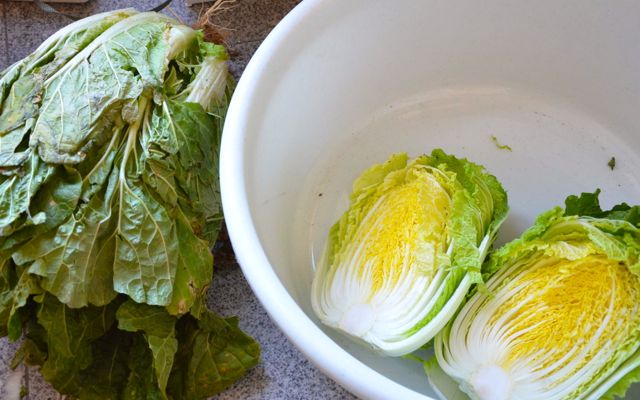
Cleaning cabbage for Kimjang kimchi Note how large the baechoo is on the left compared to the cleaned and cut ones on the right.
- Cut each cabbage in half. Tip for cutting cabbage for Kimchi: just cut about 1/3 of the bottom half (from the root end) and rip apart by hand. Like so –
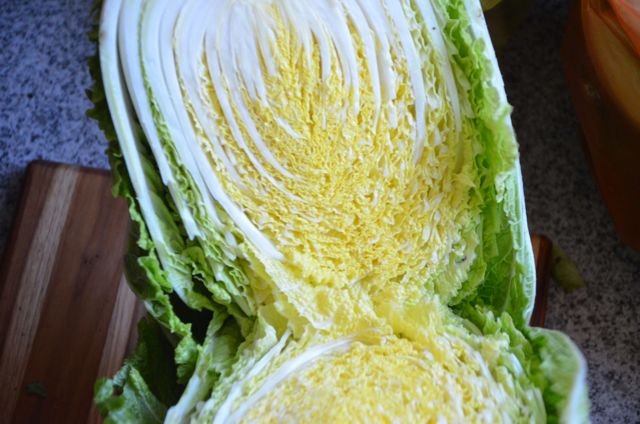
How to cut Kimjang cabbage baechoo in half It won’t be a huge disaster if you cut it all the way with a knife but it’s just easier this way and also you will not end up wasting cabbage pieces.
- In a large container, dissolve about 8 cups of salt and 17 1/2 quarts/70 Cups of cold or lukewarm water for the brine. Reserve remaining 4 cups salt for sprinkling. Please read my Kimjang tips post on discussion about salt. Solar sea salt is best if you can get them.
- Put cabbages in brine (made in step 3) – make sure the brine seeps fully into the cabbage by spreading out the leaves with your hands and swirling it around.
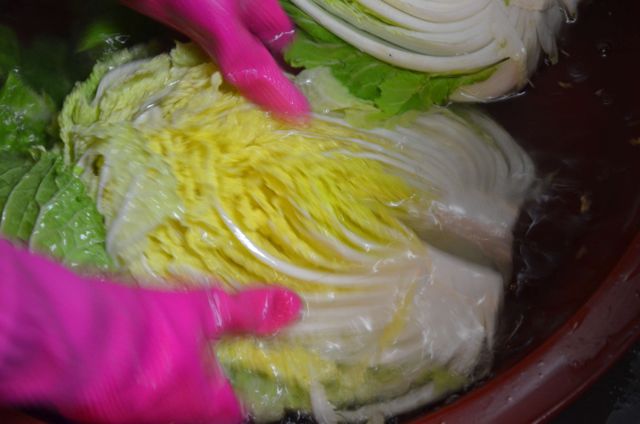
soaking cabbage in brine for Kimchi - Leave cabbages in brine for 2~3 hrs until the leaves start to get soft.
- When leaves are soft, For each 1/2 cabbage, REPEAT the following 3 steps:
-
- Take each cabbage out and let it drain for couple seconds and put in a bowl. DO NOT discard the brine because you will be putting cabbages back later on.
- Get a handful of salt from the remaining 4 cups and sprinkle (more like spraying) the salt in between leaves of each 1/2 cabbage, starting from the outer leaves. Aiming the salt mostly on the thick, white fleshy part of the cabbage.
- Put salted cabbages back into the brine.
-
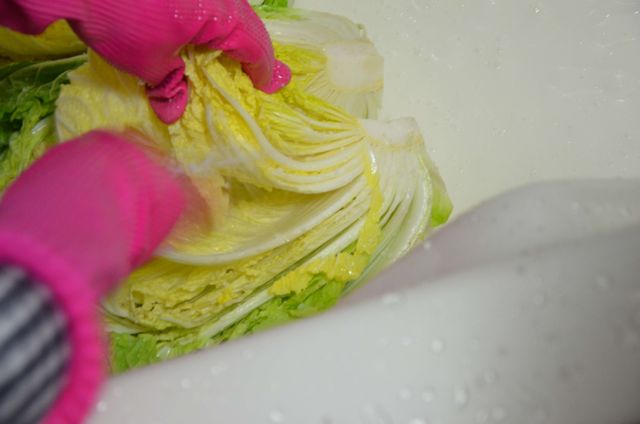
Salting cabbage for Kimchi ** We do this because the thick white fleshy part takes longer and more salt to pickle. You only need about 1/2 cup or less for each 1/2 cabbage. You may not need to do this if your cabbage has very thin white flesh or if you want to make your kimchi less salty.
7. Let cabbages sit in brine for another 10~12 hrs. Making sure cabbages are evenly pickled by rotating the ones on the top with the ones in the bottom, every 4 hrs or so.
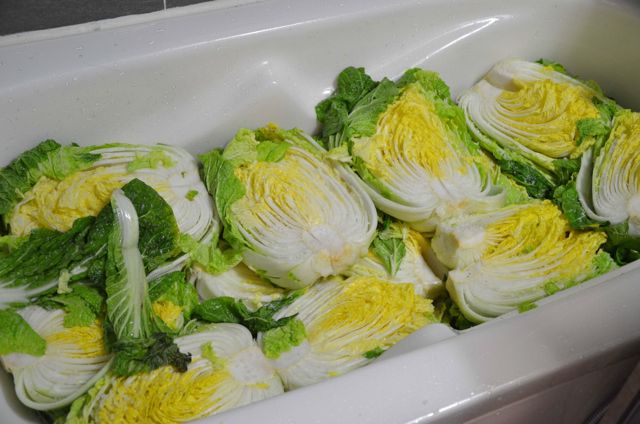
8. Next morning, the white part of the cabbage should be fully bendable like so-
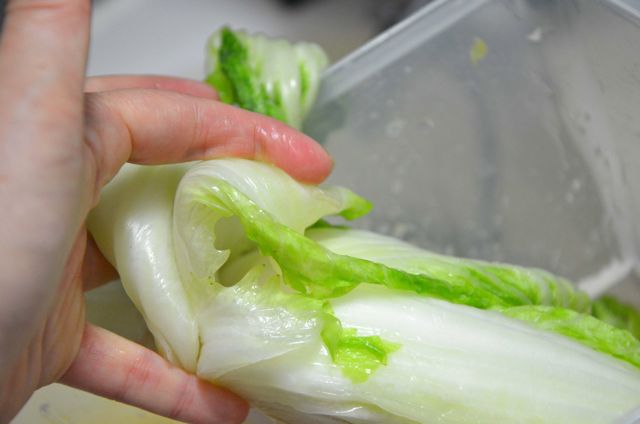
9. Rinse cabbages 3 times thoroughly. Let cabbages drain for 1 hr or so. Place the cut side down when draining.
Now you are ready to make the seasoning and finish up the Kimchi!
For the list of ingredients and recipe – see my post Kimjang Day: Part 1 – How it’s done.
For more info on ingredients and other tips – see my post Kimjang Day: Part 2 – Ingredients and Tips
Some Kimchi recipes tell you to brine cabbages for 6-8 hrs (at room temp) and this can work well for smaller batches (in fact, that’s what I do in my Easy Blender Kimchi) but traditionally, Kimjang cabbages were pickled overnight in cold winter weather.
In my opinion, brining overnight works better simply in terms of scheduling because you can start brining cabbages at night time and then finish making Kimjang kimchi the next morning. If you brine them for only 6-8 hrs, then you either end up making Kimchi at wee hours of the night or you end up starting the pickling process after midnight. None of which is fun..
So in my case, I washed and cleaned all the vegetables first during the day and then started pickling the baechoo (cabbage) in our bathtub around 7pm. Which meant I could rinse it around 8 am next morning.
Well, now you have it! With my tips on how to pickle/brine Korean cabbages for Kimchi, you should be able to make a very delicious Kimchi anytime!
About the BRINE:
- Pickling in 15% salt solution is the traditional standard for Kimchi cabbages. A recent trend is to make it less salty and many Koreans now pickle at 10~12 % salt solution. e.g. If you want to make a 10 cup brine solution, you can mix 8 1/2 C of water and 1 1/2 C salt. This is not an exact formula for making 15% but that’s what many people use to make things simpler and quicker. In this level of salinity, you will only need to pickle the cabbages in 6-8 hrs.
- Interestingly, in some coastal areas, Koreans pickle their cabbages in sea water instead of making a brine. Note, sea water’s salinity is around 3.5% to 4% which is much lower salinity than our brine so you will need to leave the cabbages much longer – usually a full 24hrs or longer.
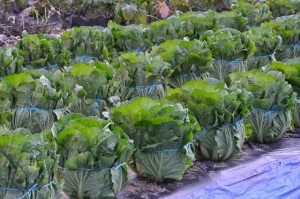
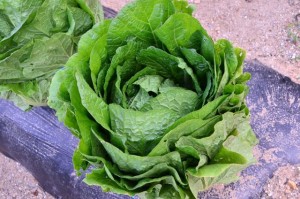
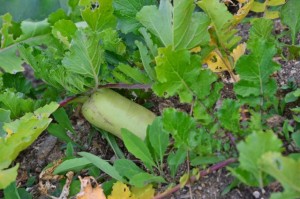
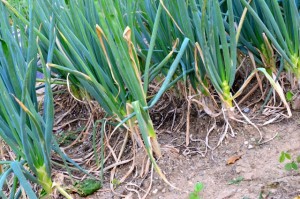
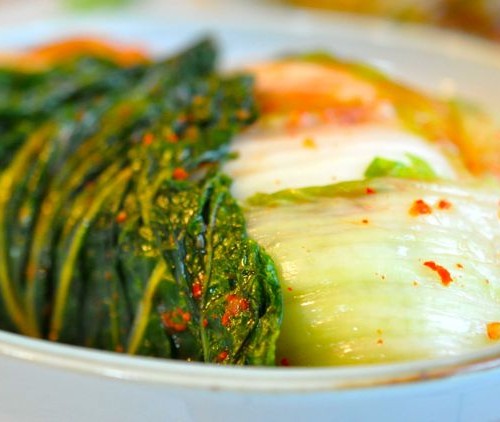
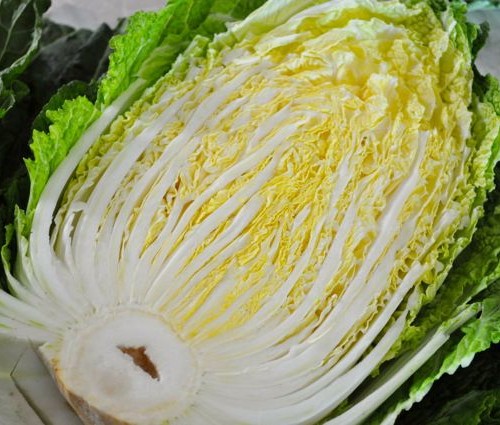

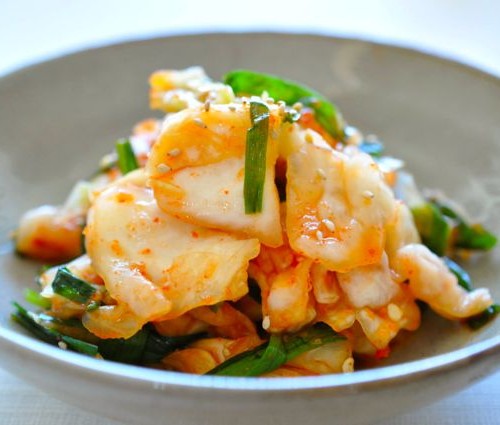
















Hi Jinjoo
Im Cecilia
I have made some mistake
I bought too many cabbage to make kimchi
But i cannot have my gochugaru for another 3-4 days
I already brine the cabbage in salt and wash
Where should i keep it before the gochugaru arrive.?
Thankyouu for answering my problem
Have a pleasant night
Oh dear!! Best way is to refrigerate your brined cabbages or keep it as cold as refrigerator temp without freezing. It should be ok for 2-3 days. Good luck!
Hello!
I made kimchi a few days ago but I’m afraid I didn’t bribe it long enough (I did a dry brine). Some leaves were bendy and some were still crunchy/breakable when I put on the paste and fermented. Will it still be edible or should I just throw it away and start a new batch?
Don’t throw it away – just see how it is. It may still turn out ok or at least some of it should be ok. Good luck!
Hi! It is my first time making kimchi yesterday, and although it is good and tasty, it’s almost a bit salty. It’s like I can’t eat it alone. I’m pretty sure it’s good to use for kimchi fried rice. Bus it there any way that I can make it less salty? It’s only been fermenting since last night. Will fermentation mellow down the saltiness?
Also, instead of using the salted fermented shrimp as is, I’ve somehow cooked it with fish sauce just to kill the raw fish smell (coz the family might not like it), cooled it down before making the paste. Was that okay? or is it necessary that I use the raw one in the future? (note: our Saeujeot here is not bottled and just fermented in batches bought at the local public market.
Is it possible to over-salt the cabbages when brining? Or does it not matter how much salt was used since it’s going to be washed anyway?
It might be that I’ve used too much salt in brining coz our cabbages are smaller ones here… or too much Saeujeot… not really sure…
Thanks in advance!
So it is supposed a bit salty when you taste it before it has fully fermented. But if you’d like to reduce the saltiness, you can do one or more of the following – add a little more sugar or maesil syrup, add fresh radish chunks (to absorb the extra saltiness). And yes, fermentation does definitely mellow down the saltiness too. But adding some radish won’t do you any harm. The raw fish smell will def. go away after it’s fermented so you probably didn’t need to do that. I think it should be OK – honestly I have never made it with cooked fish sauce I am not sure. But you can make Kimchi without fish sauce so I expect that it will be fine. So it is possible to over-salt the cabbages but what’s probably more important is how much of the salt you rinse away. If you let the brined cabbage sit too long in water, it can actually kind of come back to life. If you don’t rinse it thoroughly (usually 3 times is good), the cabbage will taste too salty. Kimchi making (although I try to make a science out of it) is such an art, it is almost impossible to make it come out perfect every time. But unless it taste WAY TOO salty, I would say it should be fine with some extra radish chunks and a bit of sweetener like sugar/pear/persimmon/apple. Good luck!
Thanks so much for the tips! It really is an art and it takes a lot of patience. I’m appreciating kimchi-making more now. Just an update, I was so excited to taste the day old kimchi I made and it did mellow out a bit, so I guess it’ll turn out great after a few more days. I’ve used some for kimchi fried rice for breakfast and it’s divine. I won’t buy store-bought kimchi ever again. I’ll be making more using your recipe and techniques in the future. Again, thank you for replying right away (coz I was so worried I ruined my kimchi).
Good to hear the happy news! Yes, once you start making your own stuff it’s hard to go back. And the more you make it, the easier it becomes so keep at it and you will become a kimchi master in no time!
I found MORTON brand Solar Salt that is from Salt Water and it is clean; have used a pinch as needed in cooking and it is good salt.
Making a batch of Kimchi with it; will pass on the results.
Ooh.. yes, please do. I would love to hear how that works out. Is there any harsh taste to it? Does it kind of taste pleasant at the end? Like you want to taste more? Anyway, look forward to hearing from you. Thank you!!
Jin joo hi! I left the cabbage to drain for too long after soaking it in salt water last night.. it smells bad now. Is it still good to use for my kimchi? the leaves turned slightly brown in the side
Hi! Hmm.. is it warm where you are? Did you rinse it before you left it to drain? If the temperature is cold,I think it should be ok but if it smells bad and the leaves are mushy – maybe sadly it’s not good. You can also taste a little to see if it taste OK. Should be salty but should taste ok. If it tastes rotten or mushy, then I would not use it. Hope it helps. Thanks for asking!